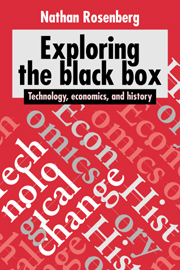Book contents
- Frontmatter
- Contents
- List of figures
- Preface
- Introduction
- Part I Dealing with an uncertain future
- Part II Technology in context
- Part III Sectoral studies in technological change
- 9 Energy-efficient technologies: past and future perspectives
- 10 Innovation in the chemical processing industries
- 11 Telecommunications: complex, uncertain, and path dependent
- 12 Understanding the adoption of new technology in the forest products industry
- 13 Scientific instrumentation and university research
- Index
9 - Energy-efficient technologies: past and future perspectives
Published online by Cambridge University Press: 12 November 2009
- Frontmatter
- Contents
- List of figures
- Preface
- Introduction
- Part I Dealing with an uncertain future
- Part II Technology in context
- Part III Sectoral studies in technological change
- 9 Energy-efficient technologies: past and future perspectives
- 10 Innovation in the chemical processing industries
- 11 Telecommunications: complex, uncertain, and path dependent
- 12 Understanding the adoption of new technology in the forest products industry
- 13 Scientific instrumentation and university research
- Index
Summary
Energy efficiency: an introduction to the fundamental issues
A distinctive aspect of successful industrialization has been the increasingly intensive utilization of energy sources in ways that have raised the productivity of other inputs, most notably labor. The close relationship between high productivity and energy-intensity is a clear empirical regularity of long-run economic growth. However, for a host of reasons, industrialized nations since the early 1970s have become increasingly concerned with the adoption of energy-efficient technologies – technologies that minimize energy utilized per unit of output.
To understand the goal of energy efficiency, some analysis must necessarily be global in nature. For example, overall constraints upon energy supplies can only be explored at the international level. Energy sources are distributed in a highly uneven fashion among countries while, at the same time, the demand for energy inputs varies enormously among countries. It is important to note that per capita income and the extent of industrialization explain an unusually high fraction of the international variation in energy demand (see table 9.1).
On the other hand, there is a great deal that can be said about the prospects and benefits of energy efficiency by confining analysis merely to the American experience. Although there will be frequent reference to the experiences of other industrial countries, historical analysis of American energy use and technology adoption will, in general, highlight a number of important forces that influence the implementation of energy efficiency. Indeed, much of the underlying analysis, although drawing upon American experience, is equally relevant and valid elsewhere.
- Type
- Chapter
- Information
- Exploring the Black BoxTechnology, Economics, and History, pp. 161 - 189Publisher: Cambridge University PressPrint publication year: 1994
- 2
- Cited by



